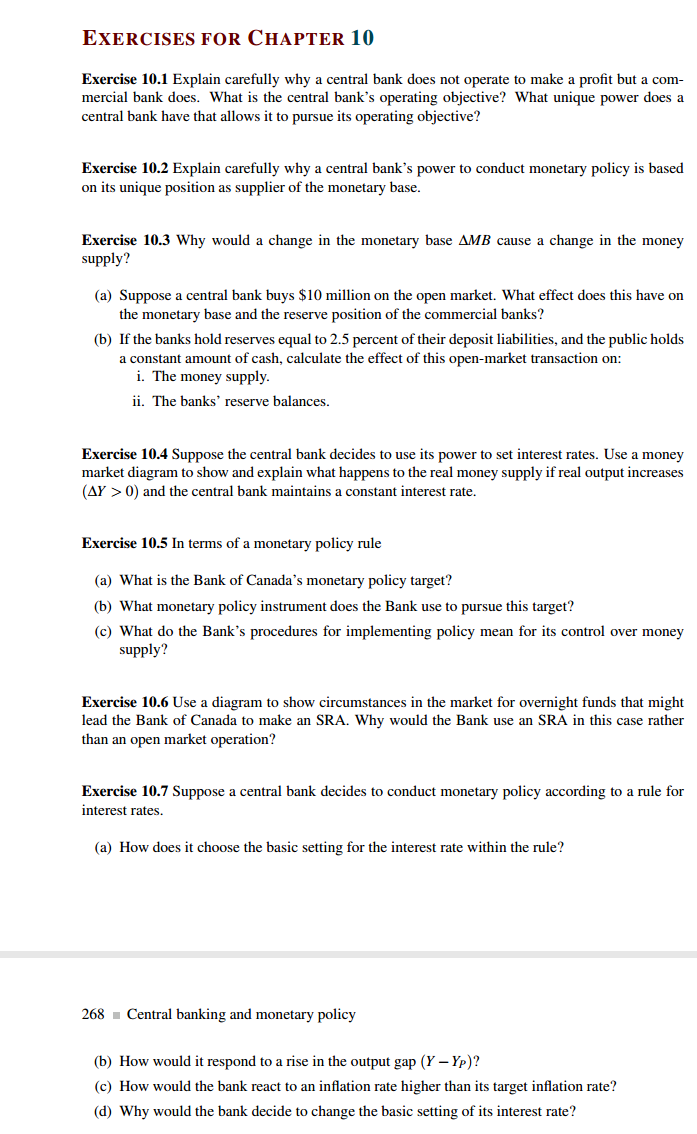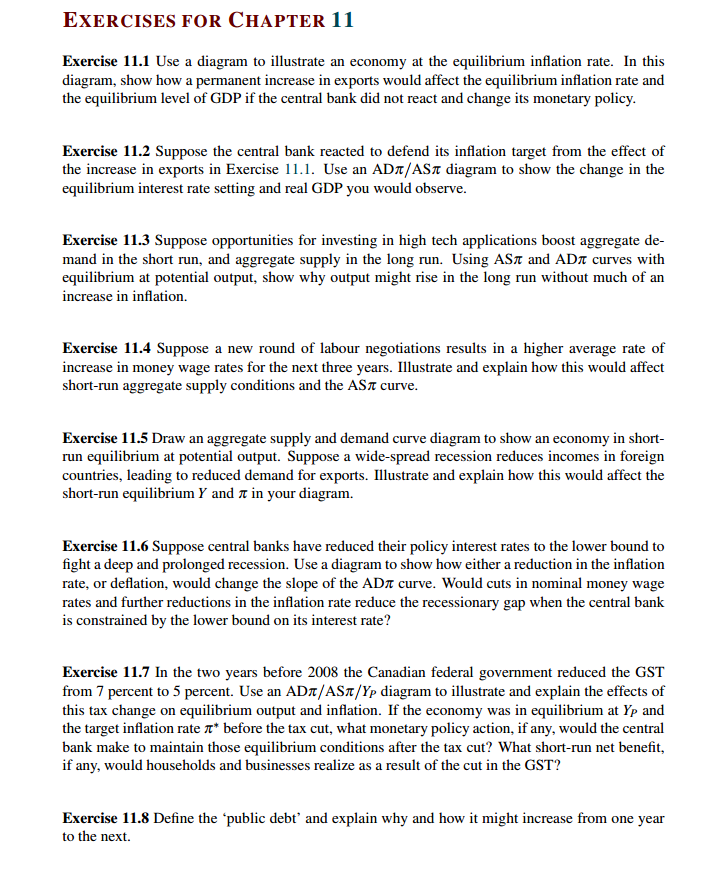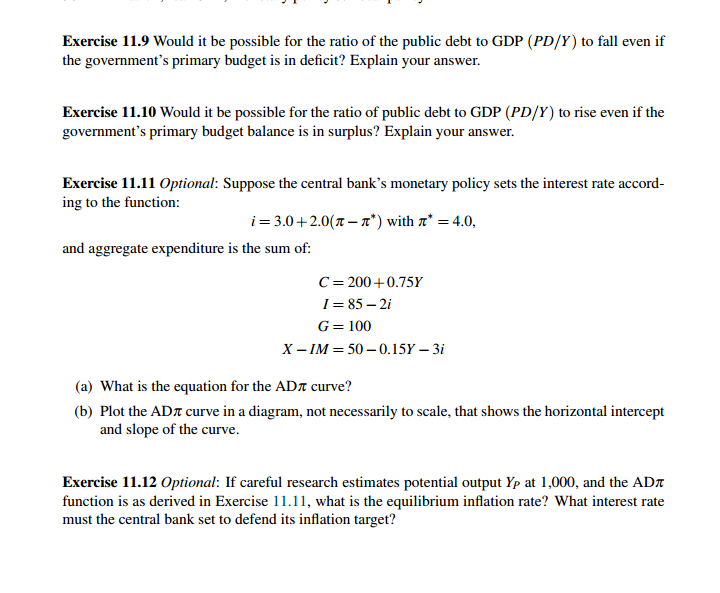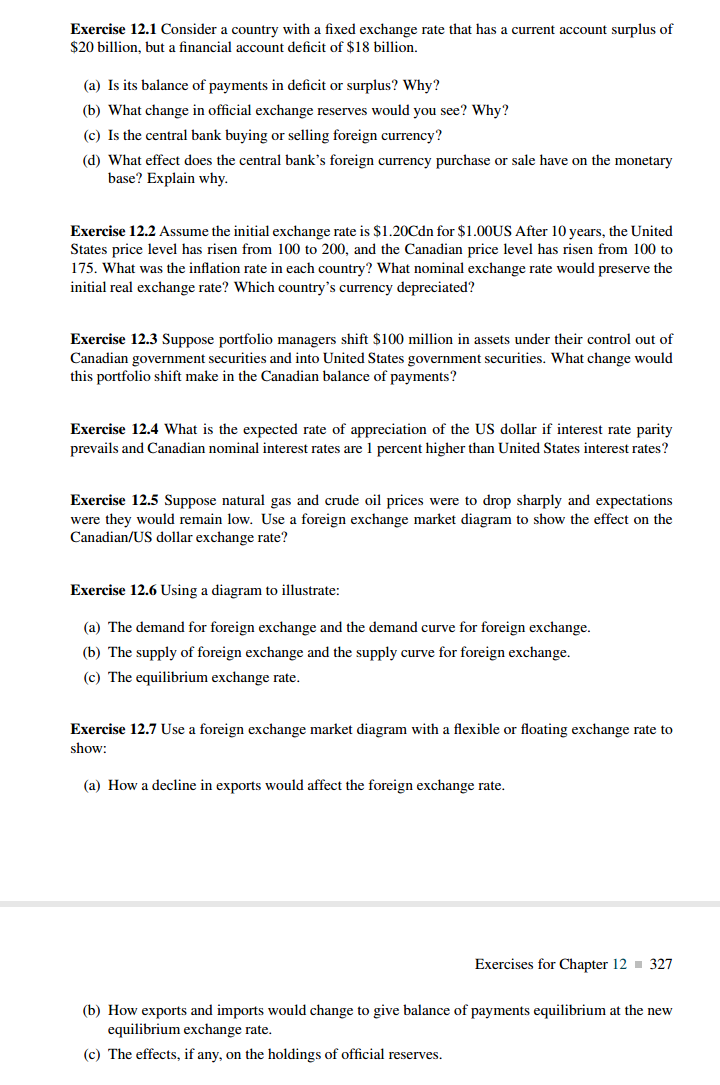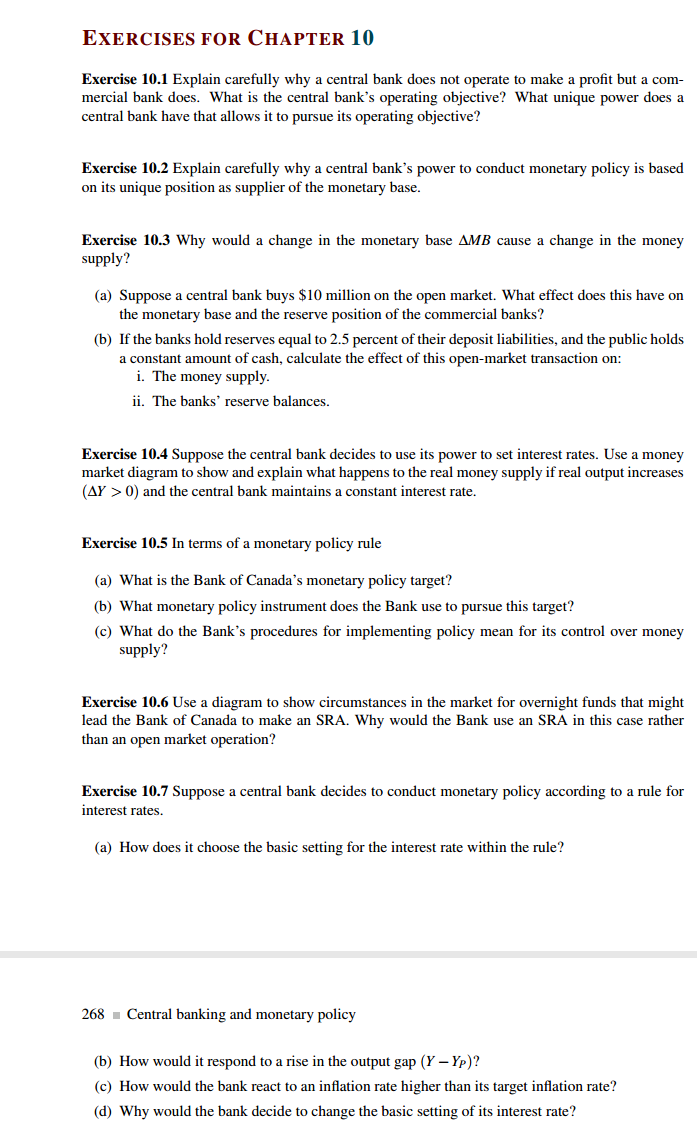
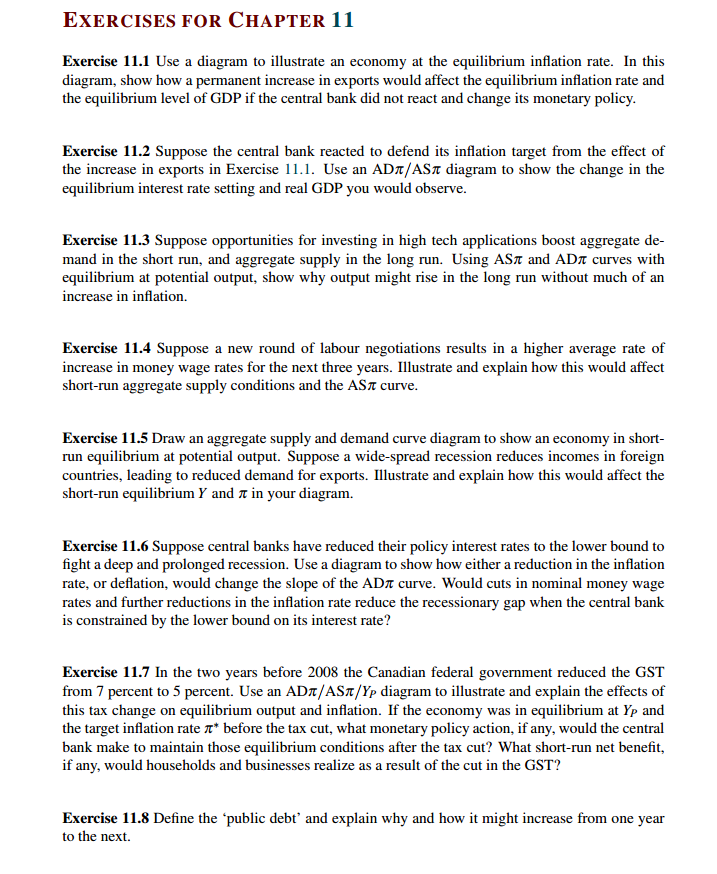
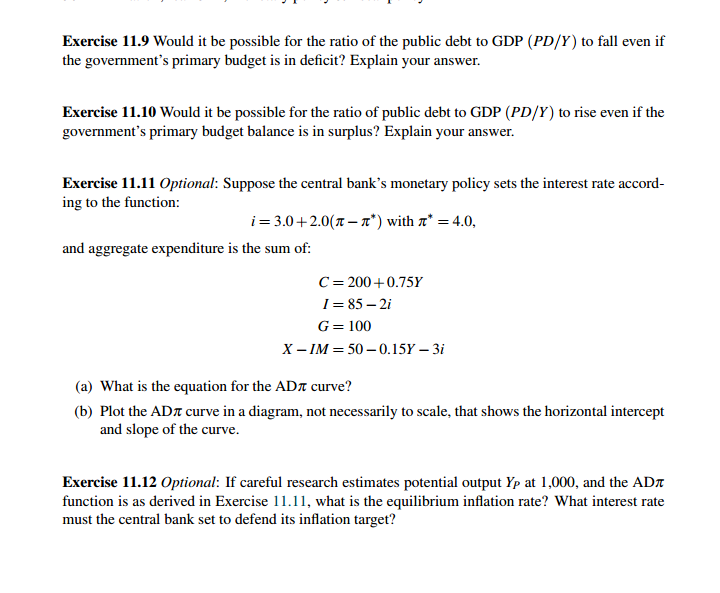
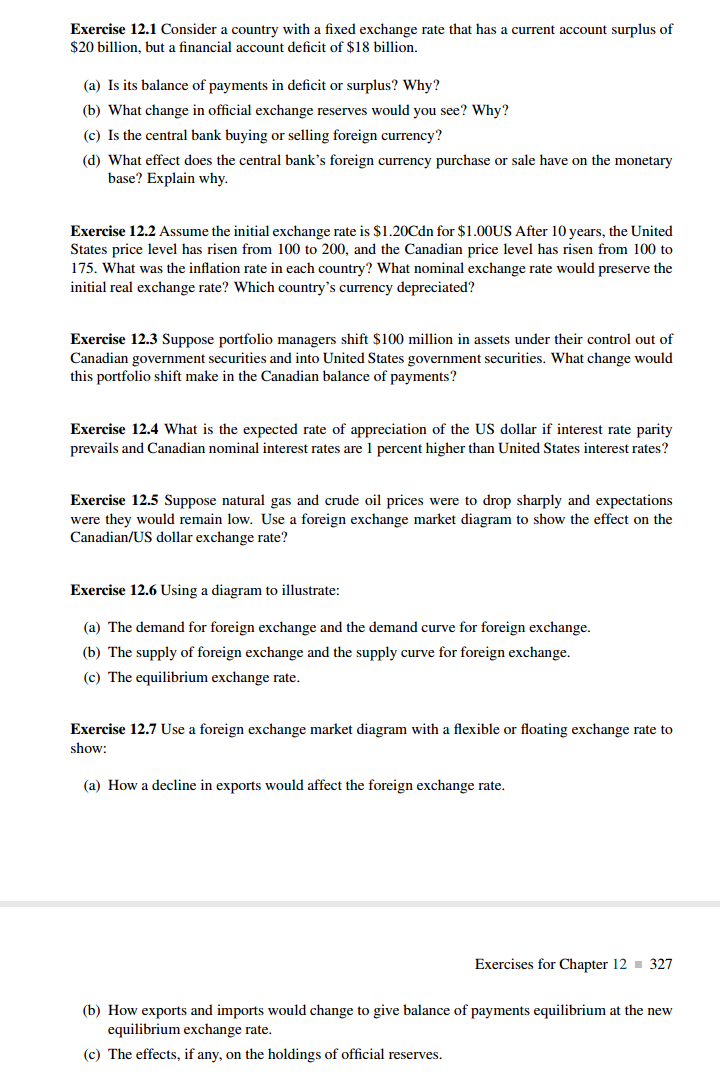
Help me please
EXERCISES FUR CHAPTER 10 Exercise 10.1 Explain carefully why a central bank does not operate to make a prot but a com mercial bank does. What is the central bank's operating objective? What unique power does a central bank have that allows it to pursue its operating objective? Exercise 10.2 Explain carefully why a central bank's power to conduct monetary policy is based on its unique position as supplier of the monetary base. Exercise lIlJ Why would a change in the monetary base dMB cause a change in the money supply? {a} Suppose a central bank buys $lil|I million on the open market. What effect does this have on the monetary base and the reserve position of the commercial banks? {b} che banks hold reserves equal to 2.5 percent of their deposit liabilitiesI and the public holds a constant amount of cashI calculate the effect of this openmarket transaction on: i. The money supply. ii. The banks' reserve balances. Exercise 111.4 Suppose the central bank decides to use its power to set interest rates. Use a money market diagram to show and explain what happens to the real money supply if real output increases [of 2.:- } and the central bank maintains a constant interest rate. Exercise 111.5 In terms of a monetary policy rule {a} What is the Bank of Canada's monetary policy target?r {b} What monetary policy instrument does the Bank use to pursue this target? (c) What do the Bank's procedures for implementing policy mean for its control over money supply? Exercise 10.15 Use a diagram to show circumstances in the market for overnight funds that might lead the Bank of Canada to make an ERA. Why would the Bank use an ERA in this case rather than an open market operation? Exercise 10.7 Suppose a central bank decides to conduct monetary policy according to a rule for interest rates. (a) How does it choose the basic setting for the interest rate within the rule? 253 I Central banking and monetary policy {b} How would it respond to a rise in the output gap (Y l'p}? {c} How would the ban}: react to an ination rate higher than its target ination rate'}I {d} Why would the bank decide to change the basic setting of its interest rate? EXERCISES FOR CHAPTER 11 Exercise 11.1 Use a diagram to illustrate an economy at the equilibrium ination rate. in this diagram, show how a permanent increase in exports would affect the equilibrium ination rate and the equilibrium level of GDP if the central bank did not react and change its monetary policy. Exercise 11.2 Suppose the central bank reacted to defend its ination target from the effect of the increase in exports in Exercise 11.1. Use an ADrrfASrr diagram to show the change in the equilibrium interest rate setting and real GDP you would observe. Exercise 11.3 Suppose opportunities for investing in high tech applications boost aggregate de- mand in the short run. and aggregate supply in the long run. Using A311: and ADE curves with equilibrium at potential output, show why output might rise in the long run without much of an increase in ination. Exercise 11.4 Suppose a new round of labour negotiations results in a higher average rate of increase in money wage rates for the next three years. Illustrate and explain how this would affect shortrun aggregate supply conditions and the 3-1511: curve. Exercise 11.5 Draw an aggregate supply and demand curve diagram to show an economy in short- run equilibrium at potential output. Suppose a widespread recession reduces incomes in foreign countries. leading to reduced demand for exports. Illustrate and explain how this would affect the shortrun equilibrinrn Y and :11: in your diagram. Exercise 11.15 Suppose central banks have reduced their policy interest rates to the lower bound to ght a deep and prolonged recession. Use a diagram to show how either a reduction in the ination rate, or deflation, would change the slope of the ADE curve. Would cuts in nominal money wage rates and further reductions in the ination rate reduce the recessionary gap when the central banlr: is constrained by the lower bound on its interest rate'iJI Exercise 11.'TI'I 1n the two years before 211133 the Canadian federal government reduced the GST from 1 percent to 5 percent. Use an ADrthSrrpr diagram to illustrate and explain the effects of this tax change on equilibrium output and ination. If the economy was in equilibrium at 1'}: and the target ination rate 11'" before the tax cutI what monetary policy action, if any. would the central bank make to maintain those equilibrium conditions after the tax cut? TWhat shortrun net benet, if any. would households and businesses realize as a result of the cut in the GET? Exercise 11.8 Dene the 'public debt' and explain why and how it might increase from one year to the next. Exercise 11.9 1Would it be possible for the ratio of the public debt to GDP (FEET) to fall even if the government's primary budget is in decit? Explain your answer. Exercise 11.111 Would it be possible for the ratio of public debt to GDP (PD! 1"} to rise even if the government's primaryr budget balance is in surplus?l Explain your answer. Exercise 11.11 Optional: Suppose the central bank's n'ionetarj.r policy].r sets the interest rate accord ing to the function: i: 3.1] +2.{l(nn"i} with II" = 4.1], and aggregate expenditure is the sum of: C=2+.?5 I=35-2i G=l XIM=5{l-{l.151'-3i [a] What is the equation for the ADE curve?II [b] Plot the ADJ! curve in a diagram, not necessarily to scale, that shows the horizontal intercept and slope of the curve. Exercise 11.11 Optional: Heareful research estimates potential output 1'}: at 1.1111}, and the ADJ! function is as derived in Exercise 1 1.11I what is the equilibrium ination rate'iI What interest rate must the central bank set to defend its ination target?II Exercise 12.1 Consider a country with a fixed exchange rate that has a current account surplus of $20 billion, but a financial account deficit of $18 billion. (a) Is its balance of payments in deficit or surplus? Why? (b) What change in official exchange reserves would you see? Why? (c) Is the central bank buying or selling foreign currency? (d) What effect does the central bank's foreign currency purchase or sale have on the monetary base? Explain why. Exercise 12.2 Assume the initial exchange rate is $1.20Cdn for $1.00US After 10 years, the United States price level has risen from 100 to 200, and the Canadian price level has risen from 100 to 175. What was the inflation rate in each country? What nominal exchange rate would preserve the initial real exchange rate? Which country's currency depreciated? Exercise 12.3 Suppose portfolio managers shift $100 million in assets under their control out of Canadian government securities and into United States government securities. What change would this portfolio shift make in the Canadian balance of payments? Exercise 12.4 What is the expected rate of appreciation of the US dollar if interest rate parity prevails and Canadian nominal interest rates are 1 percent higher than United States interest rates? Exercise 12.5 Suppose natural gas and crude oil prices were to drop sharply and expectations were they would remain low. Use a foreign exchange market diagram to show the effect on the Canadian/US dollar exchange rate? Exercise 12.6 Using a diagram to illustrate: (a) The demand for foreign exchange and the demand curve for foreign exchange. (b) The supply of foreign exchange and the supply curve for foreign exchange. (c) The equilibrium exchange rate. Exercise 12.7 Use a foreign exchange market diagram with a flexible or floating exchange rate to show: (a) How a decline in exports would affect the foreign exchange rate. Exercises for Chapter 12 = 327 (b) How exports and imports would change to give balance of payments equilibrium at the new equilibrium exchange rate. (c) The effects, if any, on the holdings of official reserves




